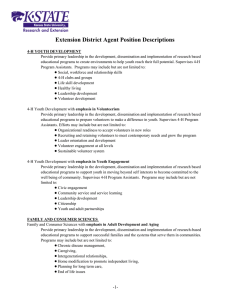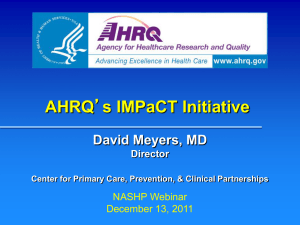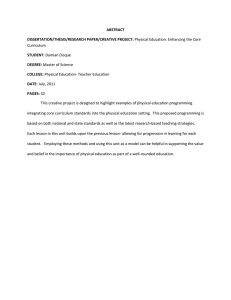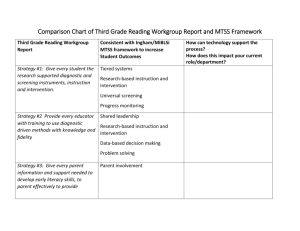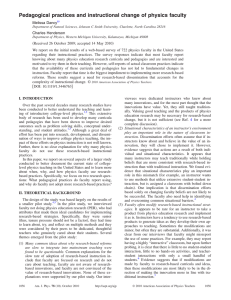Educational Transformation in STEM: Why has it been limited
advertisement
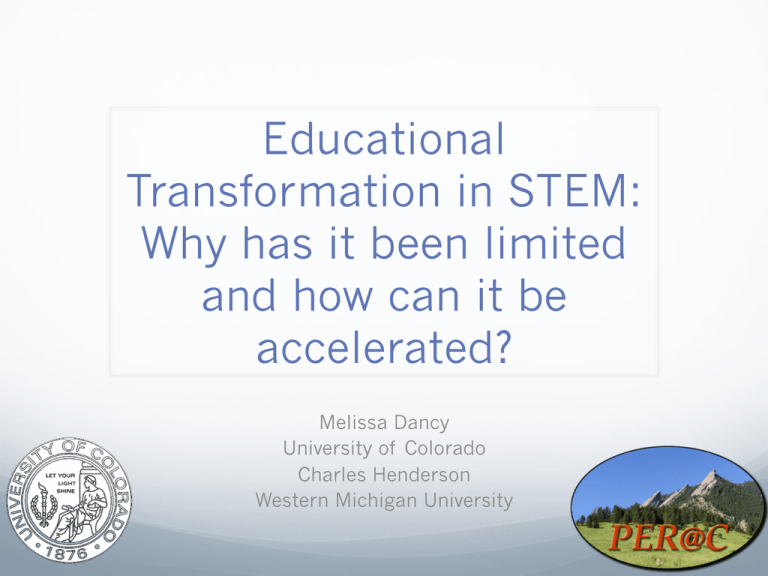
Educational Transformation in STEM: Why has it been limited and how can it be accelerated? Melissa Dancy University of Colorado Charles Henderson Western Michigan University Educational Transformation in STEM: Why has it been limited and how can it be accelerated? We have engaged in multiple projects over many years designed to understand how and why research-based teaching innovations have had limited impact on mainstream college level teaching. We have found substantial evidence that the typical “dissemination” model of change has been effective at increasing knowledge of innovations and motivation to change among individual faculty, but fails as an overall educational transformation model because it does not account for the complexity of change. Specifically, it fails to acknowledge the often substantial environmental barriers to change, it fails to support the ongoing, organic, often difficult nature of real change, and it does not recognize the importance of and subsequently utilize social dynamics in the change process. In this talk we will summarize our findings, as well as others, and offer recommendations for bringing about impactful and sustained educational transformation through a more robust change model. Big Picture Questions 1. Why has the uptake of research based reforms been slower than expected given the enormous expenditures of money, time and effort? 2. What can members of this community do to better enable research-based educational transformation? Collaborators not be displayed. Your computer may not have enough memory to open the image, or the image may have been corrupted. Restart your computer, and then open the file again. If the red x still appears, you may have to delete the image and gain. Charles Henderson Western Michigan University Chandra Thurpen University of Maryland Also thanks to, NSF (DUE-1065714, DUE-0715698) Magdalena Niewiadomska-Bugaj, Western Michigan Univ. Trisha Chapman, Rochester Institute of Technology Susan White, SRC, American Institute of Physics Data and Analysis Interviews with senior, respected, traditional physics faculty (n=5). Representative survey of physics faculty (n=722). Interviews with faculty using or knowledgeable about Peer Instruction and Workshop Physics (n=72). Longitudinal study of participants of the New Faculty Workshop (n=15) Change Agents Often Blame Faculty False! 70% of physics faculty Faculty don’t believe in or are not interested in research-based methods. report being interested in using more researchbased instructional strategies. Change Agents Often Blame Faculty False! Studies of faculty time Faculty are too busy with their research to put time into improving teaching. consistently indicate many put significant effort into teaching, often to the detriment of research. How do faculty spend their time? Activites as % of Total Time on Teaching Students 11% Other 9% In Class 18% Grading 14% Prep 48% avg hrs/week total 52 avg hrs/week teaching 30 avg hours/contact hrs 5.6 Change Agents Often Blame Fate False! Rapid social change can Change takes time. happen. (i.e. testing/ standards movement) Self-defeating thinking: when nothing happens as a result of your efforts to change the system you are not likely to rethink your efforts and try something different Development and Dissemination Model of Change Development: Specialists research student learning and develop strategies and materials with proven success. Dissemination: Publish journal articles, books and websites, give talks, run workshops …. Inform faculty of the failures lecture based methods. Introduce new methods and data showing their effectiveness. Provide curricular materials. Expect change. Wonder why change didn’t happen. Assume change takes time and/or faculty are stupid and don’t care. Repeat (perhaps louder) Assumption: Faculty can easily change if they want to. Reform is complicated! Culture, policy, resources, physical space, etc. Environment Innovative Innovative Teaching ? Traditional Teaching Traditional Students learn best when actively engaged. Individual Innovative Beliefs, goals, knowledge, experiences, personality, etc. Dissemination alone unlikely to produce sustained reform! Rogers* Stages of the Adoption Process Knowledge Persuasion Decision Implementation Confirmation *Rogers, Everett M. (1962). Diffusion of Innovations. Glencoe: Free Press. D&D Successes: Knowledge, Persuasion, Decision D&D reform model insufficient for effective and sustained reforms. Not correlated (logistic regression model) with knowing and trying RBIS Institution Variables • Type of Institution (PhD granting vs. community college) Departmental Culture Variables • Reported departmental encouragement for teaching • Frequency of talking with peers about teaching Teaching/Research Focus • % of job related to teaching • Number of research presentations given • Research grants Individual Characteristics • Highest degree obtained (Phd, Masters, etc.) • Instructional goals compatible with PER (i.e. conceptual understanding) • Academic rank • Years of teaching experience Correlated Variable READ (teaching-related journals) NFW (Physics New Faculty Workshop) ATND (talks/workshops) MORE (interest in using more RBIS) GEN (gender) SATF (satisfied with meeting goals) PSTN (full-time, permanent vs. other) RSH2 (research publications) SIZE (class size) †Controlling † Variables Know * ***** ** Tried * *** Continue High * ** * * * * * for other study variables using a logistic regression model. *Strength of effect is based on size of odds ratios (each * ~ odds ratio of 2). * * * * Big Picture Questions 1. Why has the uptake of research based reforms been slower than expected given the enormous expenditures of money, time and effort? Most reforms efforts utilize the Development and Dissemination (D&D) Model Intuitive rather than research-based model 2. What can members of this community do to better enable research-based educational transformation? Develop a research-based model for reform. Perceived Constraints Requires time and energy to change Content coverage concerns, personal belief Difficulty to getting students engaged Students aren’t capable of doing it In personal experience it did NOT work Structural, lack of resources Structural, class size Structural, lack of appropriate classroom Trouble finding good questions Difficulty getting student buy-in Current practices are effective Intuitively don’t think that PI will work % total 57.1 48.6 48.6 37.1 34.3 34.3 31.4 31.4 31.4 28.6 25.7 25.7 Content coverage concerns, external requirements 22.9 Content coverage concerns, institutional expectations 20.0 Perceived Affordances Dissatisfaction with lecture % total 57.1 Evidence of effectiveness from personal experience Gets students active Departmental support or encouragement Evidence of effectiveness from data Intuitively makes sense to me Provides feedback to the instructor Gets students working together Encourages depth of understanding 54.3 48.6 45.7 42.9 37.1 34.3 31.4 25.7 Students learn by hearing a peer’s explanation 25.7 Students learn by giving an explanation to a peer Forces more students to participate 22.9 20.0 Affordances and Constraints NON (N=10) MIXED (N=18) HIGH (N=7) Most Prevalent Affordances Most Prevalent Constraints Dissatisfaction with traditional lecture (86%) Evidence of effectiveness, personal experience (71%) Forces more students to participate (71%) Evidence of effectiveness, data (57%) PI makes intuitive sense (57%) Provides feedback to the instructor (57%) Difficulty of getting students engaged (100%) Trouble finding good questions (57%) Dissatisfaction with traditional lecture (78%) Gets students active in class (67%) Evidence of effectiveness, personal experience (56%) Departmental support or encouragement (50%) Time and energy required to change (56%) Personal commitment to content coverage (50%) Evidence of effectiveness personal experience (50%) Time and energy required to change (90%) Student deficiencies (60%) Personal commitment to content coverage (50%) Structural, Lack of resources (50%) Structural, Class size (50%) Current practice effective (50%) External requirement of content coverage (50%) Informal Postcourse Feedback Used by Institutions Used by Faculty Informal Formative Assessment Systematic Formative Assessment Exams & HW Performance Research-based Assessments Teaching Portfolios Peer Observations Student Evaluations of Teaching 0 10 20 30 40 50 60 70 80 90 % of Faculty Reporting Use for Assessment A Better Model: Collaborate with Faculty Respect faculty, their experiences and knowledge. “The first word out of their [a typical PER presenter] mouth is you’re not doing things right.” “If you tell me that you think my teaching is bad that automatically sets up a barrier.” (senior faculty) Provide modifiable curricular materials. Target “new” faculty Faculty who are teaching a course for the first time see curricular materials as a time saver. “Repeat” faculty are more likely to see them as a time sink. A Better Model: Foundation of Social Interactions Colleagues are biggest influence, not data … The most common way faculty report learning about an innovation (67%) is through a colleague. *Then* they turn toward traditional dissemination modes (i.e. papers, workshops, websites). They use data mainly to justify what they do to others. Colleagues can be barriers or affordances "some of the feedback [my department head] gave me was that I need to lecture them more … he said you should really explain these things to the letter so I am questioning myself, am I spending enough time just talking to them and explaining?” (new faculty) “We are all kind of rolling this out together and it's really nice having other people in the department who are doing this to help and support and brainstorm and work through how to make this work well.” (new faculty) A Better Model: Ongoing Implementation Support Need more research on secondary implementations “I guess my frustration is getting some of the many resources to actually work for what I’m doing and I have no idea how that hurdle can be overcome because everybody teaches their lessons in a different way. I don’t know how to beat that problem.” (new faculty) Dealing with student pushback, encouraging productive group discussions, guidelines for modifications, etc. (Virtual?) Faculty Learning Communities? “Something I’d really want in life is to have some kind of very common resources and that we talk to each other or communicate with other instructors in the field, for example [teaching] similar course and we share with each other how to teach things or something like that.” (new faculty) A Better Model: Work In Environments and Structures Teaching assessed based on student learning. Neither faculty nor their institutions know whey they are teaching well or if they are improving. Encourage structural support (i.e. redesigned rooms, clickers etc.) Encourage culture of student centered teaching. A Better Model: Ongoing Implementation Support Better access to curricular materials. “Right now, more of the time goes into finding the resources. Once that problem is solved, then more time will be spent incorporating them but, if the time to find it could be shortened, then so what if there is still some spent trying to figure out how to imbed it in my lesson?” (new faculty) Difficulties include Lacking knowledge of available resources Available resources being too time consuming to sort through Lack of information about how to adapt available resources to their unique environment. www.perusersguide.org (Sam McKagan)
